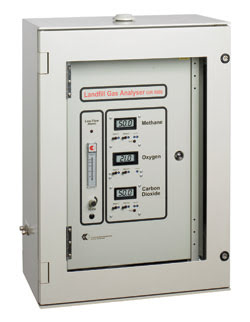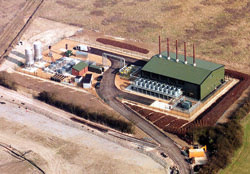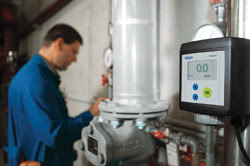Nondispersive infrared (NDIR) absorption spectroscopy detects and measures various gases by their characteristic IR absorption bands. The technique is not new, but its application to climate studies, biofuels and geological research makes it a hot topic, and a number of companies have developed small, rugged, high-precision instruments especially for environmental and process monitoring.
Since 1957, NDIR instrumentation at Mauna Loa Observatory on the Big Island of Hawaii has continuously measured carbon dioxide levels in the ambient air. Located far from pollution sources, and sampling air masses representative of the Northern Hemisphere, the observatory reveals solid evidence of the 20 per cent increase in this greenhouse gas over the past 50 years. Until 2006, the equipment was vacuum-tube-based, but the current instrument is a solid-state LI-7000 CO2/H2O analyser from Li-Cor Biosciences Inc. of Lincoln, Neb., USA, with much lower power consumption.
Li-Cor specializes in instrumentation for biotechnology and environmental research. The LI-7000 produces high-speed, simultaneous measurement of carbon dioxide and water vapour to 1 per cent accuracy. A dichroic beamsplitter and two detectors measure the two infrared absorption fingerprints at 4.255 and 2.595 μm, respectively, in the same gas stream. The high gas flow rates, input-trigger support and low signal noise also make the instrument suitable for eddy covariance studies, for verifying and tuning global climate models.
William P. Miller, environmental product manager at Li-Cor, said, “A lot of the information about the current greenhouse gas fluxes comes from the various eddy covariance networks all over the world.”
In micrometeorology, eddy covariance is one of the most direct methods of measuring CO2 and H2O exchange in turbulent fluxes within the atmospheric boundary layer. It correlates velocity of movement with gas density to measure how the gases move through unit area in unit time. The LI-7000 data combines with data from a sonic anemometer, relating wind speed and concentration.
Li-Cor also has an open-path NDIR instrument, the LI-7500, which offers lower power consumption, a wider range of operating temperatures and weatherproof aerodynamic-profile casing for in situ measurement of CO2 and H2O in turbulent air structures. Both instruments detect very small changes at a very high sampling frequency, enabling scientists to study, for example, water vapour moving from the surface of a lake into the atmosphere, or carbon dioxide moving from the air to a forest during photosynthesis.
Landfill and biogas
The Gas Sensors Div. of Edinburgh Instruments Ltd. in Livingston, UK, makes NDIR gas sensors and monitors, in both stand-alone form and as cards for OEM integration. A narrow optical bandpass filter selects the appropriate wavelength for the target gas, avoiding cross-sensitivity with other gases. The product range includes sensors for carbon dioxide, carbon monoxide, methane and ammonia, refrigerants and liquefied petroleum gas, volatile organic compounds, hexane and hydrocarbons. Applications range from landfill, biogas and horticultural monitoring to combustion processes, brewing and food processing.
Landfill sites produce very damaging greenhouse gases, but careful instrumentation can identify and help utilize them, turning a potential pollutant into a source of green energy.
Hitech Instruments Ltd. of Luton, UK, manufactures gas analysers for process applications. Its GIR5000 landfill and biogas monitor measures three gases relevant to energy extraction from biodegradation of waste. The instrument uses NDIR sensors for methane and carbon dioxide, and electrochemical sensors for oxygen and hydrogen sulphide. Most importantly for this environment, it is ATEX Zone 2 compliant, allowing its use in classified hazardous environments where potentially explosive gas mixtures may occur. In flare stack monitoring and generator set control, the GIR5000 helps to maximize efficiency and to ensure that oxygen remains below potentially explosive levels.

The GIR5000 monitors gases from the biodegradation of waste, enabling safe energy extraction and carbon tax credits. Courtesy of Hitech Instruments Ltd.
Methane makes up about 60 per cent of landfill gas and has a more damaging greenhouse effect than carbon dioxide. It also is a useful energy source, however, so most UK landfill sites use the methane to sell or run on-site generator sets, or burn it to produce heat as an energy source, providing valuable carbon tax credits. To trap the gas, bulldozers spread clay over the landfill site.
Clarke Energy Ltd. designed and installed a 14-MW power station on a wasteland site in Calvert, Buckinghamshire, UK, that runs on the landfill methane and that delivers electricity to the local grid. Ten miles of pipes and more than 200 gas wells sunk in the capped areas deliver up to 10,000 m3 of landfill gas per hour. The five lean-burn General Electric Co. Jenbacher generator engines are in individual soundproofed compartments to provide very low noise levels and to reduce the environmental impact.

This 14-MW power station in Calvert, Buckinghamshire, UK, runs on landfill methane. Courtesy of Clarke Energy Ltd.
For biogas production, anaerobic digestion uses bacteria to break down waste materials and produce usable gases, in a process similar to composting. Sewage treatment plants have employed the technique for a long time, but renewable energy legislation and carbon footprint targeting are bringing it into more widespread use. The resultant gas mixture is similar to landfill gas with the same monitoring requirements.
LumaSense Technologies A/S of Ballerup, Denmark, supplies the Innova 1412 photoacoustic field gas monitor to measure up to five gases plus water vapour quickly and accurately. Light choppers and optical filters pulse infrared light at various narrowband wavelengths through the gas mixture, simultaneously quantifying the concentrations of the five gases plus water vapour, typically with parts-per-billion sensitivity.
The choice of filter determines which gas is detected, and the instrument automatically compensates for temperature, pressure and water vapour interference. The pulsing nature of the light causes rhythmic variations in gas pressure and generates sound. Microphones measure its intensity and, thus, the concentration of the responding gas. This technique measures absolute rather than relative concentration, making it stable and accurate, with a very small sample volume.
Geological research
Dräger Safety AG & Co. of Lübeck, Germany, makes portable and fixed gas detectors using technologies that include catalytic and electrochemical sensors. Its X-am 7000 hand-held gas detector measures combustible and poisonous gases in emergency response situations such as chemical and oil terminal fires. Its Polytron 7000 provides a modular platform to display and transmit measurements of industrial gases. It detects more than 100 toxic gases, plus oxygen in ambient air.

The Polytron 7000 detects more than 100 toxic gases, for siting at multiple points in an industrial plant and employing a common display format to familiarize users. Courtesy of Dräger Safety AG & Co.
Deploying the same instrument across the plant enables users to understand and operate it easily, while its modularity enables upgrades to handle developing applications. A more economical model, the Polytron 3000, uses preset sensor types and ranges and detects a more limited number of gases, including sulphur dioxide, chlorine and ammonia, plus acidic compounds and organic vapours.
Environmental research scientists used a Dräger NDIR Polytron IR transmitter to monitor carbon dioxide efflux around volcanoes and earthquake zones and detected a significant increase eight days before an earthquake in El Salvador in 2001. Such observations eventually may help predict geological catastrophes.